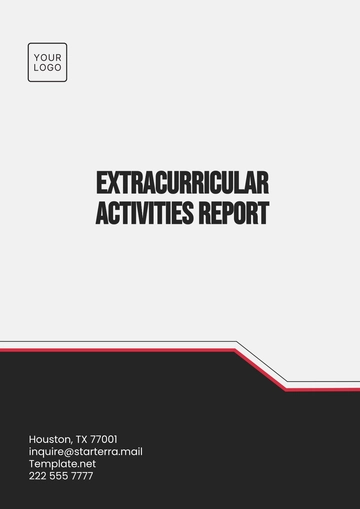Free Printable Healthcare Activity Report

Date | [Date] |
Name | [Your Name] |
Company | [Your Company Name] |
Introduction
The purpose of this report is to document and analyze the various healthcare activities conducted over the year 2050. It provides a structured and systematic method to record, track, and evaluate the effectiveness and reach of healthcare services administered. This format ensures that all important healthcare activities are meticulously captured, thereby enabling accurate reporting and insights for continuous improvement.
Healthcare Activity Overview
This section offers a broad overview of the healthcare activities undertaken throughout the year. It includes the goals, scope, and key elements of these undertakings.
Goals
Enhance patient care and treatment outcomes.
Streamline healthcare operations for efficiency.
Implement innovative healthcare technologies.
Raise public health awareness and education.
Scope
The activities covered in this report span a diverse range of healthcare domains, including preventive care, emergency services, chronic disease management, mental health services, vaccination campaigns, and telemedicine.
Detailed Healthcare Activities
This section captures detailed descriptions of specific healthcare activities conducted over the year. These activities are categorized for structured reporting.
Preventive Care
Preventive care activities focus on disease prevention and health promotion among the population. These initiatives include regular health screenings, vaccination drives, and public health campaigns targeting lifestyle modifications.
Emergency Services
Emergency services ensure immediate health assistance is available for acute ailments and accidents. This includes the operation of emergency rooms, ambulance services, and trauma care units.
Chronic Disease Management
Efforts in managing chronic diseases like diabetes, hypertension, and COPD (Chronic Obstructive Pulmonary Disease) include patient education, routine monitoring, and medication management to improve quality of life.
Mental Health Services
Mental health services aim to provide support through counseling, therapy sessions, and psychiatric care. The focus is on integrating these services into primary care for holistic health solutions.
Vaccination Campaigns
Vaccination campaigns delivered immunizations against prevalent diseases, following robust planning to achieve high coverage and compliance across various age groups within the population.
Telemedicine
Telemedicine initiatives have expanded access to healthcare by utilizing digital platforms for remote consultations, diagnosis, and follow-ups, ensuring continued care delivery irrespective of geographic barriers.
Healthcare Activities Data
The table below provides quantitative data on some essential healthcare activities executed during the year.
Healthcare Activity | Total Activities Conducted | Participation Rate | Outcome Impact |
|---|---|---|---|
Health Screenings | 50,000 | 70% | 80% detection of unrecognized conditions |
Emergency Response | 25,000 | 85% | 90% successful stabilization |
Chronic Disease Management Programs | 15,000 | 92% | 75% improvement in patient quality of life |
Mental Health Consultations | 30,000 | 50% | 60% positive feedback |
Vaccination Drives | 80,000 | 95% | Reduction in disease incidence by 85% |
Telemedicine Sessions | 100,000 | 60% | Viability increased healthcare access by 45%. |
Analysis and Findings
This section analyzes the above activities to determine their effectiveness and provides insights into areas of improvement. The analysis reveals a commendable achievement in terms of participation rates and outcome impacts for various healthcare services.
The high success rate in emergency response and vaccination drives has led to a significant reduction in fatalities and incidences of preventable diseases, respectively. Telemedicine has successfully augmented healthcare access, yet further integration and tech-literacy programs are vital to maximizing its reach and efficiency.
Conclusion
The documented healthcare activities highlight substantial progress in enhancing the healthcare delivery system throughout 2050. Future strategies should continue focusing on incorporating advanced technologies and comprehensive education for healthcare professionals and the public to maintain this momentum. Ongoing evaluation and adaptation will be crucial for sustaining these improvements and addressing emergent healthcare challenges.
Recommendations
Invest in advanced healthcare technology and training.
Promote community-based healthcare initiatives.
Enhance data collection mechanisms for real-time analysis.
Increase funding for mental health programs.
Foster public-private partnerships to expand healthcare infrastructure.
- 100% Customizable, free editor
- Access 1 Million+ Templates, photo’s & graphics
- Download or share as a template
- Click and replace photos, graphics, text, backgrounds
- Resize, crop, AI write & more
- Access advanced editor
The Printable Healthcare Activity Report Template, offered by Template.net, is a customizable, downloadable, and printable solution designed to streamline healthcare reporting. This template allows you to efficiently track and document activities with ease. Fully editable in our AI Editor Tool, it provides flexibility for tailored adjustments to suit your specific needs, ensuring an optimized and professional report every time.
You may also like
- Sales Report
- Daily Report
- Project Report
- Business Report
- Weekly Report
- Incident Report
- Annual Report
- Report Layout
- Report Design
- Progress Report
- Marketing Report
- Company Report
- Monthly Report
- Audit Report
- Status Report
- School Report
- Reports Hr
- Management Report
- Project Status Report
- Handover Report
- Health And Safety Report
- Restaurant Report
- Construction Report
- Research Report
- Evaluation Report
- Investigation Report
- Employee Report
- Advertising Report
- Weekly Status Report
- Project Management Report
- Finance Report
- Service Report
- Technical Report
- Meeting Report
- Quarterly Report
- Inspection Report
- Medical Report
- Test Report
- Summary Report
- Inventory Report
- Valuation Report
- Operations Report
- Payroll Report
- Training Report
- Job Report
- Case Report
- Performance Report
- Board Report
- Internal Audit Report
- Student Report
- Monthly Management Report
- Small Business Report
- Accident Report
- Call Center Report
- Activity Report
- IT and Software Report
- Internship Report
- Visit Report
- Product Report
- Book Report
- Property Report
- Recruitment Report
- University Report
- Event Report
- SEO Report
- Conference Report
- Narrative Report
- Nursing Home Report
- Preschool Report
- Call Report
- Customer Report
- Employee Incident Report
- Accomplishment Report
- Social Media Report
- Work From Home Report
- Security Report
- Damage Report
- Quality Report
- Internal Report
- Nurse Report
- Real Estate Report
- Hotel Report
- Equipment Report
- Credit Report
- Field Report
- Non Profit Report
- Maintenance Report
- News Report
- Survey Report
- Executive Report
- Law Firm Report
- Advertising Agency Report
- Interior Design Report
- Travel Agency Report
- Stock Report
- Salon Report
- Bug Report
- Workplace Report
- Action Report
- Investor Report
- Cleaning Services Report
- Consulting Report
- Freelancer Report
- Site Visit Report
- Trip Report
- Classroom Observation Report
- Vehicle Report
- Final Report
- Software Report




























